Books
Books

My Mother Laughs
First published in France in 2013, My Mother Laughs is the final book written by the legendary and beloved Belgian artist and director Chantal Akerman (1950-2015) before her death. A moving and unforgettable memoir, the book delves deeply into one of the central themes and focuses of Akerman's often autobiographical films: her mother, who was the direct subject of her final film No Home Movie (2015).
With a particular focus on the difficulties Akerman faced in conjunction with the end of her mother's life, the book combines a matter-of-fact writing style with family photographs and stills from her own films in order to better convey the totality of her experience. Akerman writes: With pride because I finally believed in my ability to say something that I'd had trouble saying. I told myself, I am strong for once, I speak. I tell the truth.
Chantal Akerman (1950-2015) was a Belgian film director, screenwriter, artist and professor. She is best known for her film Jeanne Dielman, 23 quai du Commerce, 1080 Bruxelles (1975), which was dubbed a masterpiece by the New York Times. During her 42 years of active filmmaking, Akerman's influence on queer, feminist and avant-garde cinema remains unmatched, her films highlighting a near-physical passage of time. Akerman's films have been shown at the Venice Film Festival, Cannes Film Festival and the New York Film Festival, among many others.
Translated by Corina Copp.
Published June 2019.

Hildegard Von Bingen's Physica
Hildegard von Bingen, Priscilla Throop
At a time when few women could write and most were denied a formal education, Hildegard von Bingen became a legendary healer, visionary, musician, artist, poet, and saint. In Physica, Hildegard presents nine "books" of healing systems: Plants, Elements, Trees, Stones, Fish, Birds, Animals, Reptiles, and Metals. In each book she discusses the qualities of these natural creations and elaborates on their medicinal use, explaining how to prepare and apply different remedies. With its emphasis on balancing the humors, Physica has strong affinity with the Oriental medical approaches gaining great respect today.
The modern reader interested in natural healing will recognize the enormous truth in the theories of this twelth-century physician, many of which prove effective today, serving as a reminder that our cures for illness depend on our natural world and our place in it.
As Hildegard states in Physica, "With earth was the human being created. All the elements served mankind and, sensing that he was alive, they busied themselves in aiding his life in every way."
Translated by Priscilla Throop a Latin and Greek scholar, she holds a master's degree from the Centre for Medieval Studies at the University of Toronto, as well as a Certificate of Advanced Theological Studies from the Episcopal Divinity School in Cambridge. She is a member of the Vermont Classical Language Association and is currently translating Isidore of Seville's Etymologiae. She lives in Charlotte, Vermont.
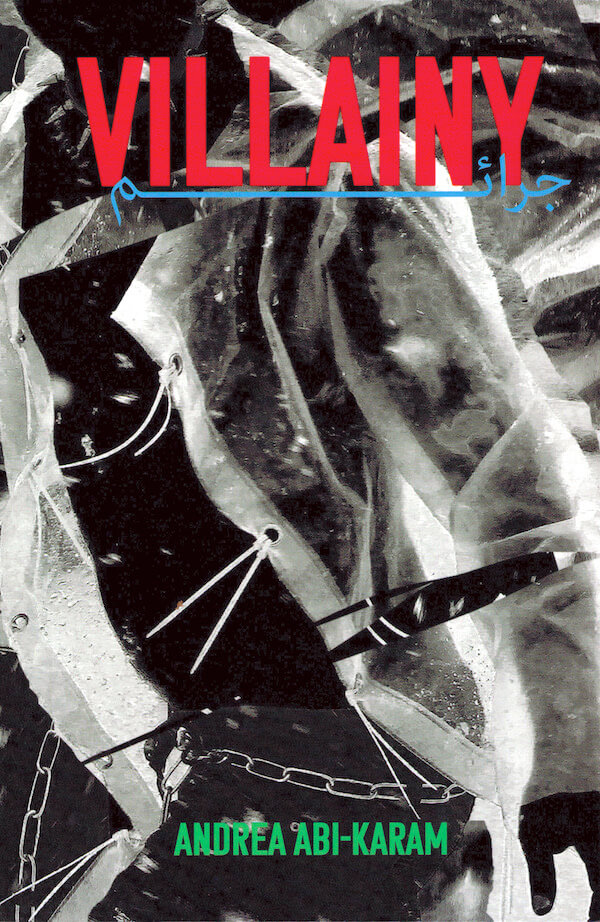
Villainy
Harnessing street protest as a poetic formation, Villainy exhibits the desires that bring queers into public space.
Andrea Abi-Karam answers the call to action for poetry itself to become the radical accomplice it was destined to be in their second book, Villainy. In order to live through the grief of the Ghostship Fire & the Muslim Ban, Villainy foments political action in public spaces, and indexes the various emotional states, such as rage, revelry, fear, grief, and desire to which queers must tend during protest. In scenes loaded with glitter, broken glass, and cum, Abi-Karam insists that in order to shatter the rising influence of new fascism we must embrace the collective work of antifascists, street medics, and queer exhibitionists and that the safety that we risk is reckless and necessary. Disruptive and demanding, these punk poems embody direct action and invite the audience into the desire-filled slippage between public sex and demonstration. At heart, Villainy aims to destroy all levels of hierarchy to establish a participatory, temporary autonomous zone in which the targeted other can thrive.
Published September 2021
Andrea Abi-Karam is an arab-american genderqueer punk poet-performer cyborg, writing on the art of killing bros, the intricacies of cyborg bodies, trauma and delayed healing. Selected by Bhanu Khapil, Andrea's debut EXTRATRANSMISSION (Kelsey Street Press, 2019), is a poetic critique of the U.S. military's role in the War on Terror. Simone White selected their second assemblage, Villainy for publication in Fall 2021 at Nightboat Books. With Kay Gabriel, they co-edited We Want It All: An Anthology of Radical Trans Poetics released by Nightboat Books in November 2020. They are a Leo currently obsessed with queer terror and convertibles.

Short Term Eternity
Anu Vahtra, Gordon Matta-Clark
"Short Term Eternity" brings together two artists – Gordon Matta-Clark (1943–1978, USA) and Anu Vahtra (1982, Estonia) – whose practices are related to each other in many ways, even if they are born in different times and locations. The aim of the book is not just to compare their work, but to describe the circling of ideas and strategies in the art world from a non-hierarchical perspective.
The book is published on the occasion of "Gordon Matta-Clark: Anarchitect. Anu Vahtra: Completion through removal", an exhibition in the Kumu Art Museum in Tallinn, February 22 – June 8, 2019, organised in cooperation between the Bronx Museum of the Arts and the Kumu Art Museum, curated by Sergio Bessa, Jessamyn Fiore, and Anu Allas.
As a contrast to the large-scale installations in both Matta-Clark’s and Vahtra’s practice, the book is small in size. The content is printed on thin paper and is divided into three parts. It starts with Completion through removal, a series of photographs by Anu Vahtra showing the spatial intervention realised in the Great Hall in Kumu and ends with the illustrated script of Vahtra’s performance piece Open House Closing. A Walk. The middle section of the book includes three thoroughly illustrated essays, where the images are printed overleaf from the text and are only visible through the page in a gap in the text at their intended location. These gaps or cuts in the text refer to the empty space, characteristic for the practices of both Matta-Clark and Vahtra.
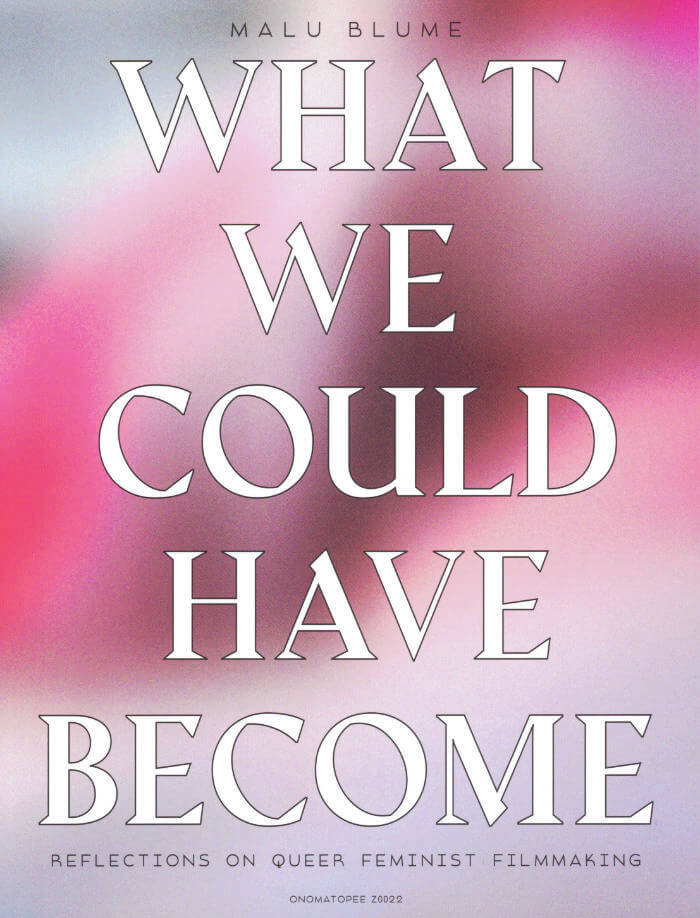
What We Could Have Become
The publication 'What we could have become: Reflections on queer feminist filmmaking' explores the radical potentials of care and speculative fiction in the context of queer feminist collective filmmaking. Departing from the experimental short film The Book of S of I (2020) by Malu Blume, this publication is a documentation of the film project just as much as its own artistic medium. Using a performative mode, it weaves together film stills with unreleased set photography, creating a visual narration that reflects caring and kinship through a queer feminist – and femme – lens.
With a foreword by editor Sascia Bailer, the booklet contains a transcript of the film’s narrative voice over and an essay on queer utopian care in the context of The Book of S of I and its making, both written by the artist Malu Blume. The publication concludes with a conversation between Malu Blume and their co-producers, friends and artistic collaborators Ipek Hamzaoglu, Laura Nitsch and Sophie Utikal, moderated by Sascia Bailer. In this conversation the artists and discuss the chances and challenges of collective film making in the context of producing The Book of S of I.
Malu Blume is a Berlin-based artist who works at the intersections of art, performance, film and education. In 2016 they completed a master's degree in Critical Studies at the Academy of Fine Arts Vienna. Malu Blume has been the co-founder and member of several collective projects on queer feminism, archival politics, friendship and collaborative knowledge production.
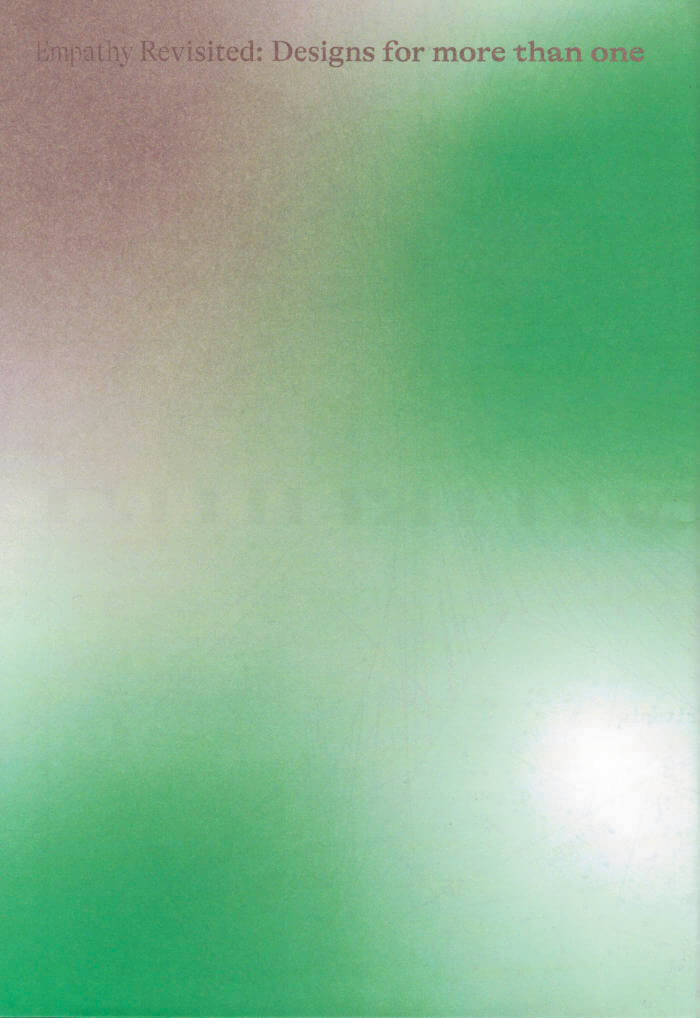
Empathy Revisited: Designs for more than one
Ideas, utopian propositions and practical solutions for reinterpreting and reconnecting empathically with the world around us.
This book brings together ideas and projects that seek to define a new role for design based on empathy.
As a mediator of emotions and feelings, design is presented here as a practice that takes care as its main purpose. Designers adopt sensitive, diplomatic, sometimes therapeutic functions, with the aim of connecting us with one another but also with the world around us, with other species, with soil, water and even the universe. In this book, the reader will find new ideas, utopian propositions but also practical solutions for reinterpreting and reconnecting with the world around them. Taking food as a key medium of encounter, both between people and also with the more than human world, the designers featured in this book consciously operate in a multi-scalar realm – from the invisible microbial life that lives in our gut to the vast landscapes transformed by agricultural practices. Designs for more than one are those that take into consideration not just their immediate user or client but the many constituents inevitably impacted by any new object or action.
Edited by Mariana Pestana with Sumitra Upham and Billie Muraben.
With written contributions by Ekin Ozbicer, Mariana Pestana, Susan Lanzoni, Naz Şahin, Billie Muraben, Sumitra Upham, FRAUD, Luigi Coppola and Vivien Sansour and Pelin Tan, Aslıhan Demirtaş, Black Athena Collective, theOtherDada, TiriLab, Counterspace, Anna Puigjaner (MAIO) with Alina Abouelenin, Aslı Uludağ, Dele Adeyemo, Young Curators Group, Eylül Şenses, Ulya Soley, Nur Horsanalı, Studio Ossidiana, Orkan Telhan + elii, Ibiye Camp, Ben Thorp Brown, Paula Gaetano Adi, Meriem Bennani, Calum Bowden, Jawa El Khash, Emmy Bacharach, Alice dos Reis, Macedo Cannat, Future Anecdotes.

Speculative Facts
Department of Speculative Facts
The Department of Speculative Facts connects two seemingly contradictory approaches: Speculation which attempts to think and act beyond existing knowledge and structures, and fact-checkers in search for a solid consensus on which our reality can be built. When stretching knowledge and speculating with fiction, what sense of responsibility is needed in times of democratized opinions and fake news? Learning from the other SF—Science Fiction—we think of speculation through facts, and facts through speculation, to situate truth culturally.
The backbone of this book is an e-mail exchange between two fact-checkers from the New York Times Magazine, which we handed over to artists to re-write, re-perform, and re-design. The publication includes the original letters, workshop scripts, as well as additional texts by philosophers, journalists, writers, and artists looking at new social contracts, with which we can anchor ourselves in the present.
Department of Speculative Facts is Lietje Bauwens, Quenton Miller, Karoline Świeżyński.
Contributions by Sepake Angiama, Lietje Bauwens (DoSF), Kate Briggs, Federico Campagna, Alex Carp & Jamie Fisher (NEW YORK TIMES MAGAZINE), Mette Edvardsen, Tristan Garcia, Maryam Monalisa Gharavi, Nicoline van Harskamp, Quenton Miller DoSF, Ingo Niermann, Michael Portnoy, Achal Prabhala with WIKIAFRICA, FACT FACTORIES, AFRICA CHECK, CHIMURENGA, Wolfgang Tillmans, Bob Trafford (FORENSIC ARCHITECTURE).
Design by Karoline Świeżyński

Philosophy for Spiders: On the Low Theory of Kathy Acker
McKenzie Wark combines an autobiographical account of her relationship with Kathy Acker with her transgender reading of Acker's writing to outline Acker's philosophy of embodiment and its importance for theorizing the trans experience.
Over the decades readers have found a punk Acker, a feminist Acker, a queer Acker, a kink Acker, and an avant-garde Acker. In Philosophy for Spiders, McKenzie Wark adds a trans Acker.
Wark recounts her memories of Acker (with whom she had a passionate affair) and gives a comprehensive reading of her published and archived works. Wark finds not just an inventive writer of fiction who pressed against the boundaries of gender but a theorist whose comprehensive philosophy of life brings a conceptual intelligence to the everyday life of those usually excluded from philosophy's purview.
As Wark shows, Acker's engagement with topics such as masturbation, sadism, body-building, and penetrative sex are central to her distinct phenomenology of the body that theorizes the body's relation to others, the city, and technology.
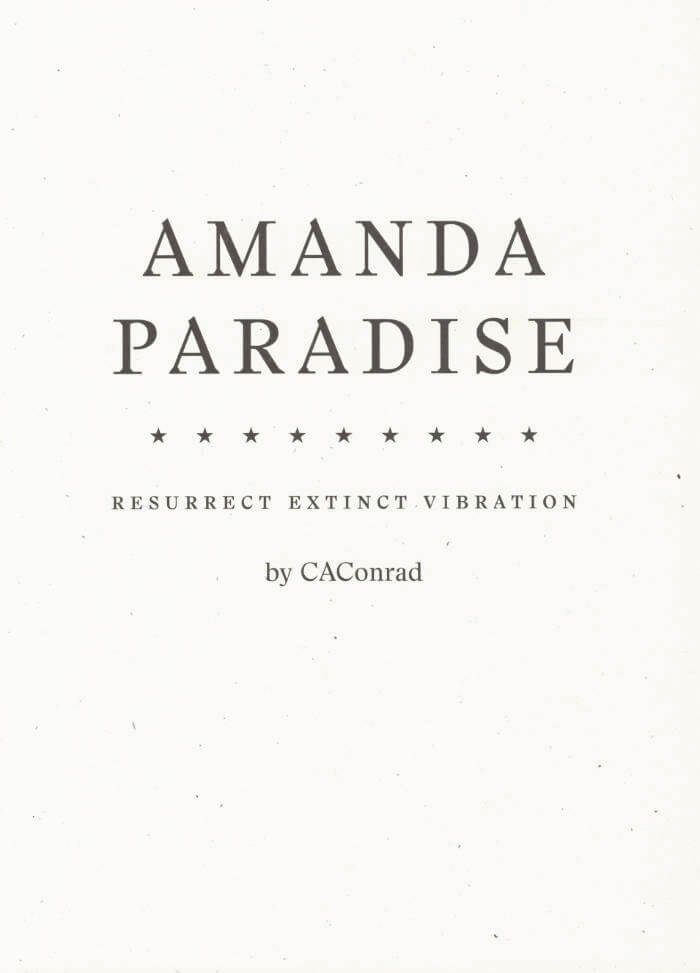
Amanda Paradise
Former United States Poet Laureate Tracy K. Smith wrote in the New York Times, "CAConrad's poems invite the reader to become an agent in a joint act of recovery, to step outside of passivity and propriety and to become susceptible to the illogical and the mysterious."
The poems in AMANDA PARADISE: Resurrect Extinct Vibration reach out from a (Soma)tic poetry ritual where CA flooded their body with the field recordings of recently extinct animals. Foundational here are the memories of loved ones who died of AIDS, the daily struggle of existing through the Corona Virus pandemic, and the effort to arrive at a new way of falling in love with the world as it is, not as it was.

Grave of Light: New and Selected Poems 1970-2005
Selected poems from a visionary feminist poet.
Considered by many to be among the most outstanding of living American poets, Alice Notley has amassed a body of work that includes intimate lyrics, experimental diaries, traditional genres, the postmodern series, the newly invented epic, political observation and invective, and the poem as novel. This chronological selection of her most notable work offers a delineation of her life and creative development. Formerly associated with the second generation of the New York School, Notley has become a poet with a completely distinctive voice. Grave of Light is a progression of changing forms and styles—an extensive panorama held together explicitly by the shape of the poet's times. Notley's poems challenge their subjects head-on, suffusing language with radiant truth.

The Works of Guillaume Dustan (Vol. 1)
Guillaume Dustan' first three novels, published in French between 1996 and 1998, describing the narrator's sexual odyssey through a Paris still haunted by AIDS.
This volume collects a suite of three wildly entertaining and trailblazing short novels by the legendary French anti-assimilationist LGBTQ+ writer Guillaume Dustan. Published sequentially in France between 1996 and 1998, the three novels are exuberant and deliberately affectless accounts of the narrator's sexual odyssey through a Parisian club and bath scene still haunted by AIDS.
In My Room (1996) takes place almost entirely in the narrator's bedroom. The middle volume, I'm Going Out Tonight (1997) finds him venturing out onto the gay scene in one long night. Finally, in Stronger Than Me(1998) the narrator reflects on his early life, which coincided with the appearance and spread of the AIDS virus in France.
A close contemporary of Dennis Cooper, Brett Easton Ellis, Kevin Killian, and Gary Indiana, Guillaume Dustan's deadpan autofiction is at once satirical and intimate, and completely contemporary.
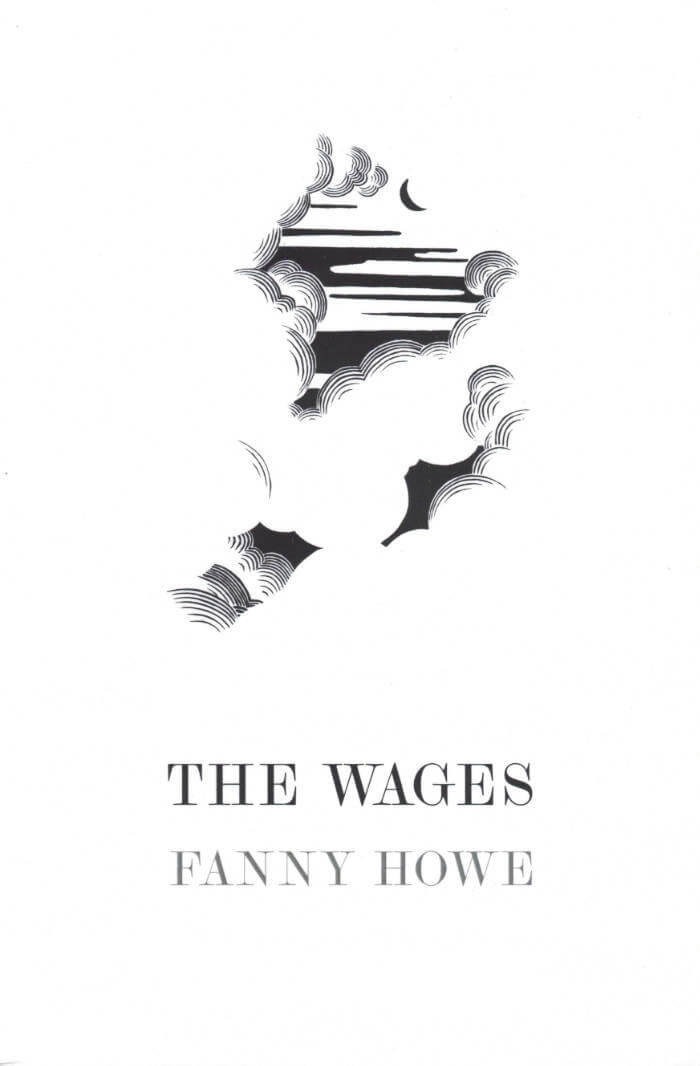
The Wages
Born amidst tragedy and implacable hatreds, the young Peter McCutcheon is denied his freedom, his birthright, and the fruits of his labors by cruel masters, and by a society and history which denies the truth.
THE WAGES is a monument to individual courage and to the ongoing injustices caused by the suppression of memories and the oppression of people. It is also a powerful document of America's entanglement in slavery and vicious myths of race. The wages of sin, according to the Bible, is death. Fanny Howe's novel demonstrates that the wages of hate are pain, and a cost not always borne by the perpetrator, or even the current generation.
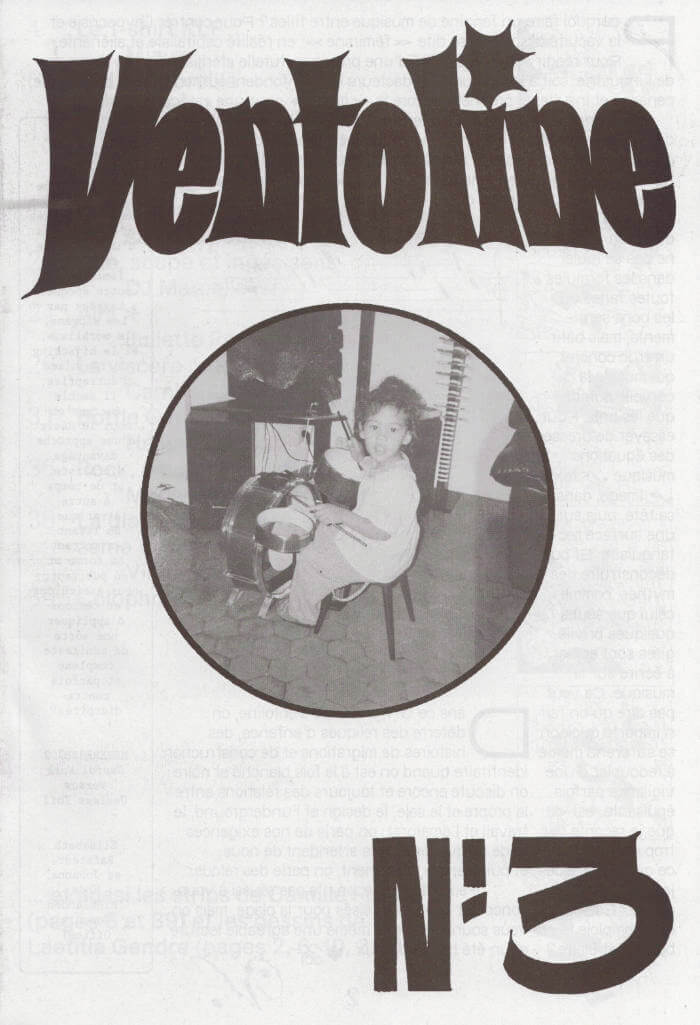
Ventoline #3 – été 2021
Pourquoi faire un fanzine de musique entre filles? Pour contrer l’hypocrisie et la vacuité d’une presse dite «féminine», en réalité capitaliste et aliénante; pour réagir soit à l’insipidité d’une presse culturelle stérilisée par les discours de l’industrie, soit à la morgue de rédacteurs qui confondent authenticité et beaufitude, panache et insulte, et prennent encore la «meuf» pour une catégorie musicale.
Pour se rencontrer physiquement ou virtuellement, soulever des cailloux ensemble, échanger nos habits, éclairer les doutes autant que les évidences, se sentir moins seules. Pour se sortir un peu d’un flux digital qui nous rend malades, s’affranchir des likes, tanguer entre passé et futur (c’est quoi l’«actualité»? ça commence quand, ça finit quand?). Pour ne pas se rouler dans les formules toutes faites ou les bons sentiments, mais bâtir un truc concret, qui muscle la cervelle autant que les bras. Pour essayer de dresser des équations musique—texte—image dans sa tête, puis dans une surface rectangulaire. Et puis déconstruire des mythes, comme celui qu’il y a des gens qui peuvent écrire sur la musique et d’autres pas. Ça veut pas dire qu’on fait n’importe quoi, on se surprend même à redoubler d’une vigilance parfois épuisante: est-ce que je raconte pas trop ma vie? Est-ce qu’on voit que je fais du second degré? Est-ce qu’emploie le bon vocabulaire?
Dans ce 3e numéro de Ventoline, on déterre des reliques d’enfance, des histoires de migrations et de construction identitaire quand on est à la fois blanche et noire; on discute encore et toujours des relations entre le propre et le sale, le design et l’underground, le travail et l’amatorat; on parle de nos exigences et de ce que les autres attendent de nous; et puis parfois, forcément, on parle des relous.
Faute de temps, on n’a pas réussi à vous concocter de mots-croisés pour la plage, mais on vous souhaite quand même une agréable lecture et un été bien moelleux.
Les contributrices :
Miaux / Mia Prce (Anvers)
miaux.bandcamp.com
Hélène Marian (Paris)
https://www.helenemarian.com
Nelly Chevaillier (Paris)
instagram.com/nllchvllr
Anne Vimeux (Marseille)
http://sissi-club.com
Inès Di Folco
instagram.com/inesdifolco
rosemercieband.bandcamp.com
http://www.red-lebanese.com/index.php/music/mi-nina-ep—pira-pora/
Camille Foucou (Marseille)
instagram.com/camillefoucou
Juliette Romero
instagram.com/julietteromeroaaa
Camille Lavaud (Paris / Dordogne)
camillelavaud.com
Hélène Barbier
helenebarbier.bandcamp.com
celluloidlunch.com
Marie-Pierre Bonniol (Berlin)
studiowalter.com
julietippex.com
Victoria Palacios (Bruxelles)
instagram.com/victoriapalacios
Camille Potte (Marseille)
camillepotte.fr
Laetitia Gendre (Bruxelles)
laetitiagendre.com
DJ Marcelle (Amsterdam)
anothernicemess.com

Atlas Europe Square
Atlas Europe Square documents a body of work by Swiss artist Yves Mettler who, since 2003, has engaged in an ongoing mapping and documentation of these sites, along with a series of projects triangulating between particular squares, interrogating their differing architectural, environmental, and public functions, and what they tell us about the ideality of ‘Europe’ and the (im)possibility of its concrete instantiation.
Here this work is extended into reflections on the relationship between art and public space, site-specificity, and the artist’s own implication in the imaginary of Europe as he becomes enmeshed in a network of projects, funds, and public bodies that seek to promote ‘European culture’ through art.
With contributions by Reza Negarestani, Laurent Thévenot, Teresa Pullano, Stephen Zepke, Neil Brenner.
Published September 2021

The Matrix: Poems 1960-1970
Originally published by Doubleday and Company in 1970, N.H. Pritchard's The Matrix was one of a tiny handful of books of concrete poetry published in America by a major publishing house. Sadly, the book was given little support and was not promoted, and it has long been out of print. However, it remains a cherished item for fans of poetry due to its unique composition, and difficult but rewarding poetics. Forcing the reader to straddle the line between reading and viewing, the book features visual poems that predate the experiments of the Language poets, including words that are exploded into their individual letters, and columns of text that ride the edge of the page.
Praised as a "FREE souled" work by Allen Ginsberg, The Matrix feels as fresh and necessary today as when it was first published. This new facsimile edition, copublished by Primary Information and Ugly Duckling Presse, makes the book available to a new generation of readers.
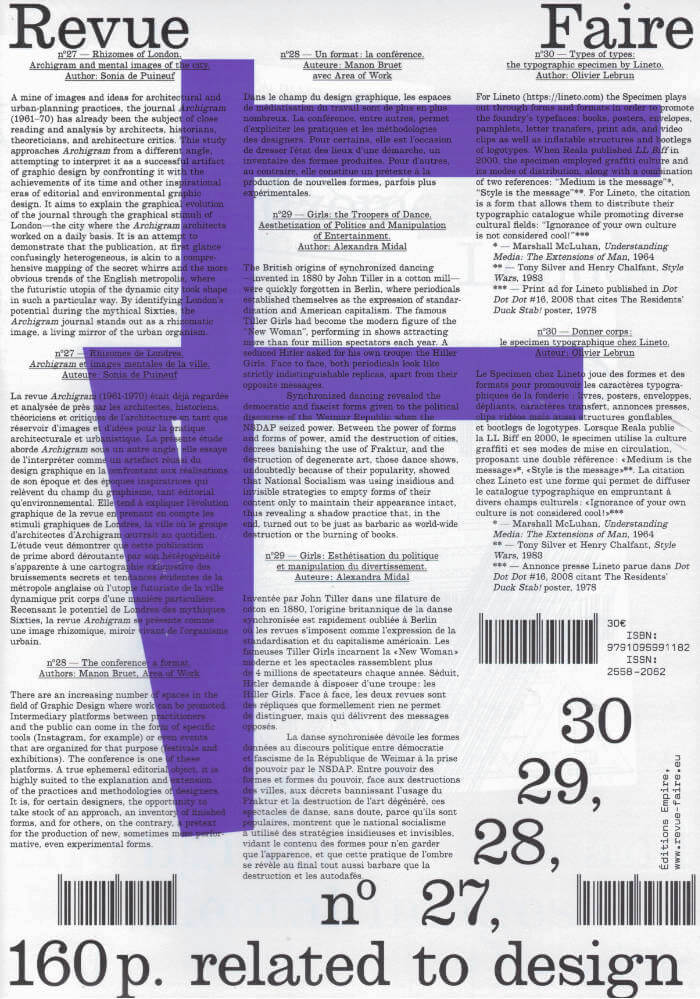
Revue Faire - Issues 27-30
Critical publications dedicated to the analysis of Graphic Design are sadly few and far between today, particularly in France, but also in Europe as a whole.
Adopting an analytical and critical posture with regard to the forms and activities of Graphic Design, Sacha Léopold and François Havegeer established in 2017 a printed publication that deals with these practices. The publication works with eight authors (Lise Brosseau, Manon Bruet, Thierry Chancogne, Céline Chazalviel, Jérôme Dupeyrat, Catherine Guiral, Étienne Hervy and Sarah Vadé).
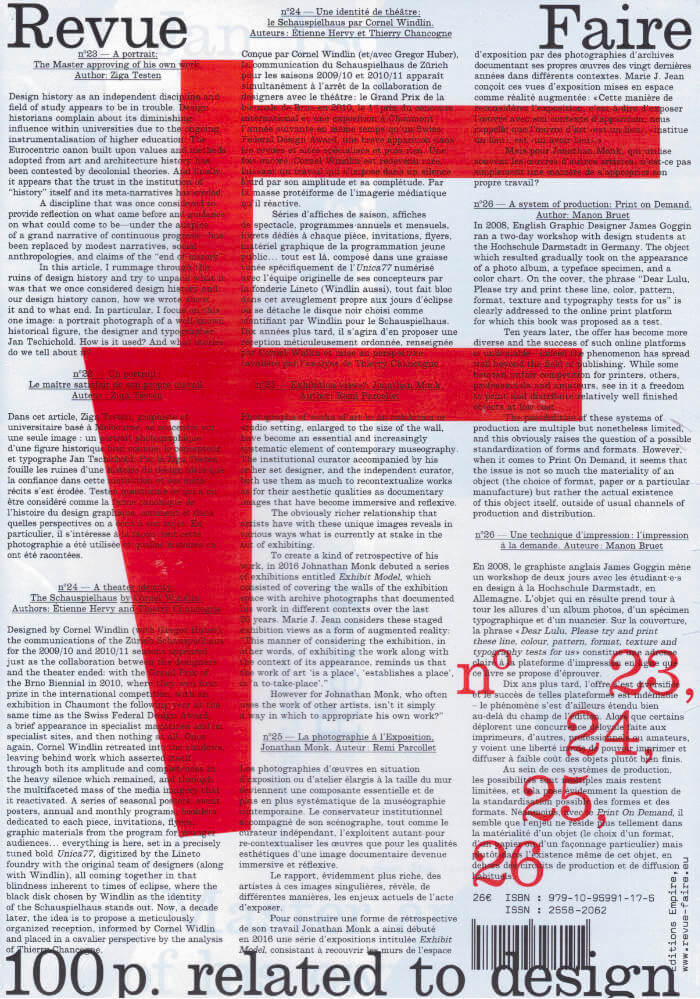
Revue Faire - Issues 23-26
Critical publications dedicated to the analysis of Graphic Design are sadly few and far between today, particularly in France, but also in Europe as a whole.
Adopting an analytical and critical posture with regard to the forms and activities of Graphic Design, Sacha Léopold and François Havegeer established in 2017 a printed publication that deals with these practices. The publication works with eight authors (Lise Brosseau, Manon Bruet, Thierry Chancogne, Céline Chazalviel, Jérôme Dupeyrat, Catherine Guiral, Étienne Hervy and Sarah Vadé).

On Freedom: Four Songs of Care and Constraint
So often deployed as a jingoistic, even menacing rallying cry, or limited by a focus on passing moments of liberation, the rhetoric of freedom both rouses and repels. Does it remain key to our autonomy, justice, and well-being, or is freedom's long star turn coming to a close? Does a continued obsession with the term enliven and emancipate, or reflect a deepening nihilism (or both)? On Freedom examines such questions by tracing the concept's complexities in four distinct realms: art, sex, drugs, and climate.
Drawing on a vast range of material, from critical theory to pop culture to the intimacies and plain exchanges of daily life, Maggie Nelson explores how we might think, experience, or talk about freedom in ways responsive to the conditions of our day. Her abiding interest lies in ongoing "practices of freedom" by which we negotiate our interrelation with, indeed, our inseparability from others, with all the care and constraint that entails, while accepting difference and conflict as integral to our communion.
For Nelson, thinking publicly through the knots in our culture, from recent art-world debates to the turbulent legacies of sexual liberation, from the painful paradoxes of addiction to the lure of despair in the face of the climate crisis, is itself a practice of freedom, a means of forging fortitude, courage, and company. On Freedom is an invigorating, essential book for challenging times.

Museum of Bone and Water
Originally published in English in 2003, Nicole Brossard's Museum of Bone and Water delivers sensual and provocative investigations of the human body, our physical and spiritual museums of identity and desire — that pulse and surprise at every turn. In this collection, fingers, lips, fists, cheeks mingle in the palm trees of Dublin and Key West, the heat of Palermo and Madrid. With each dazzling turn and each "crazy" silence, Brossard speeds our breath and quickens our hearts, reminding us that poetry too is both a physical and spiritual reality.
Museum of Bone and Water, a finalist for the Governor General's Literary Award, is recognized as a major work in the oeuvre of leading Québécoise poet, novelist, and essayist Nicole Brossard, recently honoured with the Lifetime Recognition Award by the Griffin Trust for Excellence in Poetry.

The Gloria Anzaldúa Reader
AnaLouise Keating, Gloria Anzaldua
A collection of published and unpublished writings of the groundbreaking Chicana writer and self-described "chicana dyke-feminist, tejana patlache poet, writer and cultural theorist" Gloria Anzaldua.
Gloria Anzaldúa (1942-2004) was a visionary writer whose work was recognized with many honors, including the Before Columbus Foundation American Book Award, a Lambda literary award, the National Endowment for the Arts Fiction Award, and the Bode-Pearson Prize for Outstanding Contributions to American Studies. Her book Borderlands/La frontera was selected as one of the 100 Best Books of the Century by Hungry Mind Review and the Utne Reader. AnaLouise Keating, Professor of Women's Studies at Texas Woman's University, is the author of Women Reading, Women Writing: Self-Invention in Paula Gunn Allen, Gloria Anzaldúa, and Audre Lorde; editor of Anzaldúa's Interviews/Entrevistas and EntreMundos/AmongWorlds: New Perspectives on Gloria Anzaldúa; and co-editor, with Anzaldúa, of this bridge we call home: radical visions for transformation.
AnaLouise Keating, Professor of Women's Studies at Texas Woman's University, is the author of Women Reading, Women Writing: Self-Invention in Paula Gunn Allen, Gloria Anzaldúa, and Audre Lorde; editor of Anzaldúa's Interviews/Entrevistas and EntreMundos/AmongWorlds: New Perspectives on Gloria Anzaldúa; and co-editor, with Anzaldúa, of this bridge we call home: radical visions for transformation.

Paul Takes the Form of a Mortal Girl
It's 1993 and Paul Polydoris tends bar at the only gay club in a university town thrumming with politics and partying. He studies queer theory, has a dyke best friend, makes zines, and is a flaneur with a rich dating life. But Paul's also got a secret: he's a shapeshifter. Oscillating wildly from Riot Grrrl to leather cub, Paul transforms his body and his gender at will as he crosses the country; a journey and adventure through the deep queer archives of struggle and pleasure. Paul Takes the Form of a Mortal Girl is a riotous, razor-sharp bildungsroman whose hero/ine wends his/her way through a world gutted by loss, pulsing with music, and opening into an array of intimacy and connections.
"HOT" (Maggie Nelson) - "TIGHT" (Eileen Myles) - "DEEP" (Michelle Tea)
Paul Takes the Form of a Mortal Girl is a riotous, razor-sharp bildungsroman whose hero/ine wends his/her way through a world gutted by loss, pulsing with music, and opening into an array of intimacy and connections.
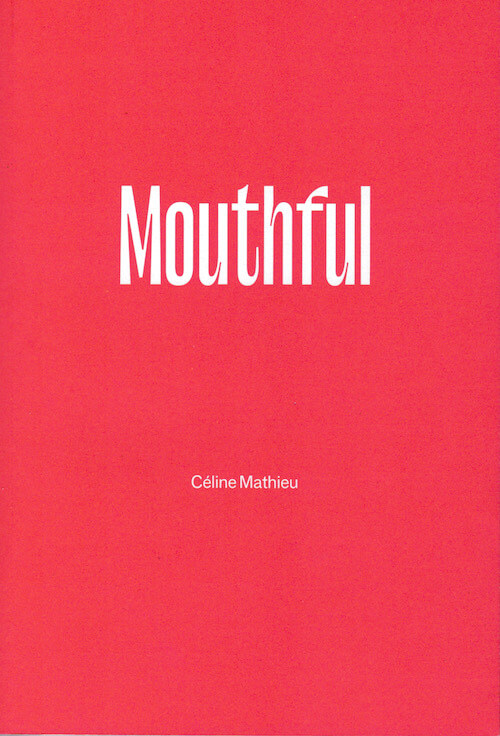
Mouthful
"She has fallen forward again, resting there like a reptile basking in the January sun. Where she was, in her corner, temperatures rose up to 28 degrees Celsuis. Her dry skin darkened, drinking the light."
In 2020, CMMC –Céline Mathieu and Myrthe van der Mark– were invited by organisers NICC Lodgers to perform at M HKA in Antwerp in response to art subsidy cuts in Flanders. Their contribution, The Writing Performance, was an attempt to write a novella each in three days, during the museum’s opening hours and in full sight of visitors. Throughout The Writing Performance, CMMC subsisted on water and sugar.
Published 2021.

"Vögel / Birds"
The book (DE/EN) gathers a selection of five short stories and two poems written between 2018 – 2021 by Benedikt Bock.
1st edition (400)
Copy editing German original: Frederike Niebuhr (linguistic services)
Translation and Proofreading: Good and Cheap Translators

Midwinter Day
Midwinter Day, as Alice Notley noted, is an epic poem about a daily routine. A poem in six parts, Midwinter Day takes us from awakening and emerging from dreams through the whole day-morning, afternoon, evening, night-to dreams again:...
a plain introduction to modes of love and reason/ Then to end I guess with love, a method to this winter season/ Now I've said this love it's all I can remember/ Of Midwinter Day the twenty-second of December// Welcome sun, at last with thy softer light/ That takes the bite from winter weather/ And weaves the random cloth of life together/ And drives away the long black night!